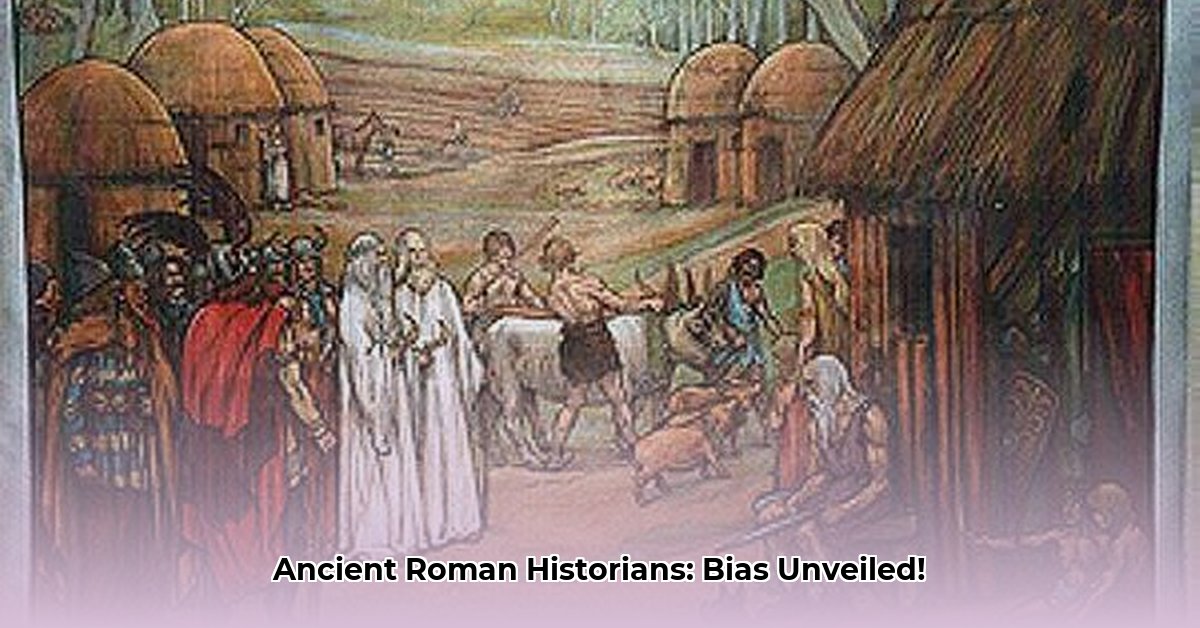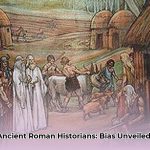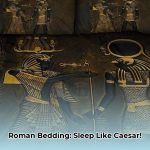Ever wanted to truly grasp what transpired in ancient Rome, beyond the popular dramas and simplified narratives? The most authentic understanding emerges from the meticulous, albeit complex, works of ancient historians themselves. Figures like Livy and Tacitus stand as original chroniclers, detailing the lives of emperors, the intrigues of senators, and the vast sweep of Roman society. Their extensive writings are rich with drama, political maneuvering, and enduring lessons on power and human nature.
For more in-depth exploration, these are best books on Roman history. Yet, a crucial truth remains: these historians were inherently subjective. Each possessed unique perspectives, personal experiences, and political agendas. Their accounts, therefore, cannot be accepted without careful scrutiny. To genuinely understand ancient Rome, one must delve deeper, question assumptions, and cross-reference information. This article explores the vital contributions of key Roman historians, unveils the pervasive biases within their narratives, and offers actionable strategies for discerning the underlying truths in their invaluable works. By recognizing their methodologies and motivations, you can unlock a far richer, more nuanced understanding of the ancient world.
The Architects of Roman History: Chroniclers Through the Ages
Much of our intricate knowledge of Rome’s past stems from the diligent efforts of its ancient historians, who navigated varied methodologies and evolving linguistic landscapes. While Greek pioneers like Herodotus and Thucydides are often lauded as foundational figures in historical writing, their Roman counterparts developed distinct, often imperially-centric, viewpoints, deeply influenced by their own society’s values and political shifts.
Titus Livius (Livy): The Moral Narrator of Rome’s Glory
Born in Patavium (modern Padua) in 59 BCE, Livy dedicated his life to a monumental undertaking: Ab Urbe Condita (“From the Founding of the City”). This sprawling work, originally comprising 142 books, chronicled Roman history from its legendary beginnings in 753 BCE to his contemporary era, the reign of Emperor Augustus. Only about a quarter of his magnum opus survives, but the remaining volumes provide an extensive account of Rome’s development, military campaigns, political transformations, and societal shifts.
Livy, writing during Augustus’s principate, aimed to inspire national pride and civic virtue, emphasizing heroic narratives and the steadfast Roman character. His history is often infused with patriotic fervor, idealizing Rome’s past and celebrating its moral rectitude. This moralizing tone, while engaging, serves as a filter through which events are presented. For example, his portrayal of figures like Cincinnatus often highlights idealized Roman virtues of simplicity and duty, serving didactic purposes. Understanding Livy requires appreciating his role not merely as a chronicler, but as a cultural architect reinforcing Roman identity.
Publius Cornelius Tacitus: The Incisive Critic of Imperial Power
Active during the late 1st and early 2nd centuries CE, Tacitus is considered one of the greatest Roman historians, renowned for his critical and uncompromising analysis of the early Roman Empire. His major works, Annals and Histories, unflinchingly expose the darker facets of imperial rule, meticulously documenting pervasive corruption, intricate political intrigues, and the perceived moral decay within the ruling elite.
Tacitus’s prose is characterized by its sharp conciseness, biting irony, and profound psychological insight. He consistently highlighted the degeneration of the Roman state, a perspective deeply shaped by his personal experience under emperors like Domitian. His Annals, covering the reigns of Tiberius, Claudius, and Nero, are particularly known for their somber tone and focus on the abuses of power, offering a cynical counterpoint to Livy’s idealism. For instance, his depiction of Tiberius is notably grim, emphasizing the emperor’s paranoia and cruelty. This divergence – from Livy’s often celebratory tone to Tacitus’s cynical critique – underscores the vital importance of exploring multiple historical voices.
Gaius Julius Caesar: The Victor’s Own Account
A pivotal figure in Roman history, Julius Caesar (100–44 BCE) was not only a general and statesman but also a historian of his own campaigns. His Commentarii de Bello Gallico (Commentaries on the Gallic Wars) and Commentarii de Bello Civili (Commentaries on the Civil War) offer seemingly firsthand insights into his military strategies, political actions, and interactions with various peoples.
However, Caesar’s “commentaries” are more than objective reports; they function as sophisticated political propaganda. Written in clear, concise Latin, they aimed to justify his controversial actions, bolster his public image, and shape the narrative to his advantage. For example, his accounts often portray Gallic tribes as inherently aggressive, thereby legitimizing his conquests. More than 75% of our direct knowledge of the Gallic Wars comes from Caesar’s own writings, prompting critical evaluation of his motives and the inherent self-serving nature of his historical presentation.
Gaius Sallustius Crispus (Sallust): A Moral Diagnostician of Decline
A contemporary and supporter of Julius Caesar, Sallust (86–35 BCE) offered a trenchant critique of the Roman Republic’s structural decline. His significant monographs, Bellum Catilinae (The Conspiracy of Catiline) and Bellum Jugurthinum (The Jugurthine War), are less concerned with chronological dates than with dissecting the moral failings of those in power. Sallust observed the Republic collapsing from within, attributing its decay to the insatiable greed and rampant ambition of the elite.
Sallust’s style deliberately diverged from the prevailing literary norms, employing an older, more austere form of Latin characterized by striking conciseness and unusual syntax. This stylistic choice aimed to imbue his writing with gravity and moral authority, profoundly impacting later literary figures like Tacitus. His nuanced portrayal of figures such as Catiline, who he explores beyond a simplistic villain, reveals his capacity for deeper socio-political analysis.
Gaius Suetonius Tranquillus (Suetonius): Imperial Biographer of Anecdotes
Born around 69 CE, Suetonius served as an imperial secretary, granting him access to imperial archives and firsthand information about the lives of Roman emperors. He is best known for his De Vita Caesarum (The Lives of the Caesars), a collection of twelve biographies covering the Julio-Claudian and Flavian emperors from Julius Caesar to Domitian.
Suetonius’s work is invaluable for its rich biographical detail and candid portrayal of emperors. He famously included personal and sometimes salacious anecdotes about their private lives, adding depth and a humanized, often sensationalized, view of these powerful figures. While entertaining, the historical accuracy of these anecdotal stories should always be approached with a healthy degree of skepticism, as their inclusion often served to titillate or subtly discredit.
Polybius: The Greek Witness to Roman Ascendancy
A pivotal Greek historian (c. 200–c. 118 BCE), Polybius was taken to Rome as a hostage after the defeat of Macedon. His Histories cover the period between the outbreak of the First Punic War (264 BCE) and the Sacks of Carthage and Corinth (146 BCE), detailing Rome’s conflicts against Hellenistic powers. Polybius attributed Rome’s unparalleled success to a synergistic combination of its citizenry’s character, the robustness of its political institutions, and the influence of Tyche (fortune or destiny). He was a staunch advocate for designing a “universal history,” emphasizing the crucial need to connect the trajectories of various regions to Rome’s inexorable ascent. His rigorous methodology, often cross-referencing multiple sources, was groundbreaking for its era, striving for an empirical understanding of cause and effect.
Diodorus Siculus: The Expansive Compiler
Active in the 1st century BCE, Diodorus, a Greek from Sicily, authored The Library of History, one of the largest works of antiquity. This universal history spanned from mythological times to the mid-1st century BCE, originally consisting of 40 books, though only 15 survive in full. Diodorus, a compiler, drew from many earlier and now lost sources, making his work a valuable repository. However, his method of combining disparate sources without critical evaluation means his accounts can sometimes be inconsistent or reflect the biases of his original materials.
Cassius Dio: The Senatorial Perspective
A Greek historian and senator during the 2nd and early 3rd centuries CE, Cassius Dio (c. 155–235 CE) wrote a comprehensive Roman History in 80 books, covering from Rome’s foundation to his contemporary era. Only fragments and summaries survive for much of the earlier periods, with significant portions remaining for the imperial age. His extensive political career provided him with invaluable access to imperial records and a unique insider’s perspective on Roman administration and politics. Dio’s work is methodical and analytical, offering insights into imperial governance, but also subtly reflects the perspectives of the senatorial class.
Ammianus Marcellinus: The Last Great Pagan Historian
Born around 330 CE in Antioch, Ammianus Marcellinus was a Roman soldier and historian, often regarded as the last great Roman historian of the classical tradition. His Res Gestae (“The Deeds”) covered the period from Emperor Nerva to the Battle of Adrianople in 378 CE. Although originally 31 books, only the last 13 survive. Ammianus provided detailed, often eyewitness, accounts of military campaigns, political intrigues, and social conditions during a period of significant imperial crisis. His work is praised for its meticulous detail and relative impartiality, though his pagan sympathies can be discerned when discussing Christian emperors.
Christian Historians: A New Theological Lens
With the rise of Christianity, a new wave of historians emerged, viewing events through a theological framework. Eusebius of Caesarea (c. 260–340 CE), often called the “Father of Church History,” wrote Historia Ecclesiastica, interpreting historical events as unfolding according to divine providence. Later figures like Orosius (c. 385–420 CE), a Christian apologist, framed Roman decline not as a failure, but as a path to Christian salvation in his History Against the Pagans. These authors, while valuable, consistently align historical facts with religious doctrine, fundamentally shaping their narratives and interpretations.
The Inherent Subjectivity: Decoding Historian Bias
A fundamental principle when approaching ancient historians is recognizing their inherent human fallibility. They were not impartial chroniclers; their personal experiences, deeply held beliefs, political allegiances, and even the patronage they received invariably shaped their historical narratives. For instance, Sallust, an overt supporter of Caesar, inevitably presented events from a particular political viewpoint. Similarly, Christian historians of late antiquity, such as Eusebius, naturally interpreted historical events through a theological framework, which understandably colored their historical records.
Identifying these biases is not an act of dismissing these invaluable historical writings entirely. Rather, it involves engaging with them through a discerning lens, understanding the interpretative filters through which historical events are conveyed to us. By actively recognizing potential biases, we can strive to interpret their writings in a more accurate and nuanced manner, leading to a richer understanding of Roman society. Do these ancient accounts truly reflect reality, or are they carefully constructed narratives designed to persuade, to praise, or to criticize?
To summarize common types of bias found in ancient Roman historiography, consider the table below, which highlights how different motivations shaped historical accounts:
| Historian Category | Primary Motivation / Potential Bias | Manifestation in Works |
|---|---|---|
| Patriotic/Moralizing | Livy: Strong desire to glorify Rome’s past, promote republican virtues, and provide moral lessons. Emphasized national heroism and an idealized Roman character to inspire contemporary citizens. | Idealization of early Roman figures (e.g., Cincinnatus, Romulus). Selection of events that showcase Roman stoicism, piety, and military prowess. Downplaying of internal conflicts or moral failings where they might tarnish Rome’s image. Narratives often blend myth and legend to reinforce foundational national narratives. |
| Cynical/Critical | Tacitus: Deep skepticism towards imperial power, strong moral judgments against corruption, and a focus on the decline of traditional Roman values. Believed power inevitably corrupts, particularly under autocratic rule. | Unflinching exposure of imperial abuses, tyranny, and debauchery (e.g., Nero’s excesses, Tiberius’s paranoia). Emphasis on moral decay among the elite. Often portrays emperors and the court in a negative light, highlighting their vices and hypocrisies. Use of stark, often ironic, prose to convey a sense of disillusionment and fatalism about the Empire’s trajectory. |
| Political/Apologetic | Julius Caesar: Self-promotion and justification of his controversial actions and political ambitions. Aimed to portray himself as a brilliant military strategist and benevolent leader whose actions were for the good of the Republic. | Presents his military campaigns (e.g., Gallic Wars) as necessary, defensive actions. Minimizes his own casualties while exaggerating enemy numbers and atrocities. Portrays conquered peoples in a manner that justifies their subjugation. Omits or downplays information that might cast him in a negative light (e.g., his wealth, his political maneuvers against rivals). His “Commentaries” served as a powerful form of political propaganda. |
| Sectarian/Religious | Christian Writers (e.g., Eusebius, Orosius): Promotion of Christian faith and interpretation of historical events through a religious and providential lens. Saw history as God’s plan unfolding, with paganism leading to decline and Christianity leading to salvation. | Selective inclusion or emphasis on events that support Christian doctrine (e.g., martyrdoms, divine interventions, the fall of pagan empires as divine judgment). Portrayal of pagan emperors and traditions in a negative light. Focusing on the spread and triumph of the Church. Their historical accounts served evangelistic and apologetic purposes, structuring history around a pre-ordained theological narrative rather than purely secular causes and effects. |
| Specific Agenda | Sallust: Strong political alignment (initially with Caesar), sharp criticism of the Roman aristocracy, and a distinct moralizing tone against perceived corruption. Used historical events as case studies to diagnose the Republic’s moral and institutional decay. | Focus on the moral character of individuals and institutions rather than simple chronology (e.g., detailed psychological portraits of Catiline, Jugurtha). Critiques of the Roman Senate and the wealthy elite. Explicitly attributes Rome’s problems to greed and ambition. His works are often didactic, aiming to provoke reflection on contemporary moral and political issues. |
| Anecdotal/Sensational | Suetonius: Interest in the personal lives and eccentricities of emperors, often including scandalous or salacious details. Aimed to provide comprehensive biographical accounts, sometimes prioritizing entertaining anecdotes over strict political or military analysis. | Detailed accounts of private habits, physical characteristics, family scandals, and rumors (e.g., Caligula’s madness, Nero’s artistic pretensions). While offering a more “human” view, the emphasis on personal vices can sometimes overshadow political achievements, and the veracity of some anecdotes is questionable, potentially serving to entertain or subtly criticize through gossip. |
Fragmented Puzzles: Piecing Together the Past Imperfectly
Imagine attempting to complete a complex jigsaw puzzle, only to discover that a significant number of pieces are either missing, damaged, or belong to different sets. This scenario closely mirrors the profound challenge encountered when delving into the works of ancient Roman historians. Tragically, many of their original texts are incomplete, exist only in fragments preserved by later copyists, or have been irretrievably lost to the inexorable march of time, often due to fire, neglect, or the simple decay of ancient materials. This inherent fragmentation makes reconstructing a truly comprehensive and seamless picture of the Roman past extraordinarily difficult.
For instance, much of Livy’s massive Ab Urbe Condita survives only in epitomes (summaries) made by later authors, or as scattered fragments quoted in other works. We possess only 35 of his original 142 books, meaning vast periods of Roman history are known to us only through secondary summaries or are entirely obscured. Similarly, two of Tacitus’s most important works, the Annals and Histories, are not fully preserved. The Historia Augusta, a compilation of biographies of Roman emperors from Hadrian to Carinus (117-284 CE), serves as a prime example of a problematic source. Its authorship, precise dating, and even its underlying purpose remain shrouded in academic mystery, with historians continuing to vigorously debate its overall reliability and veracity, often suspecting it contains fabrications or personal opinions disguised as fact.
Despite these inherent gaps and uncertainties, these surviving fragments can still yield invaluable insights into the past, provided readers approach them with informed caution and a critical mindset. Acknowledging the inherent limitations of available primary sources is absolutely vital for achieving accurate and balanced historical interpretation. Can we ever truly know the whole story when so much has been lost to antiquity, and what remains is often incomplete or compromised? This historical detective work demands intellectual rigor and a










